Exploring Stockings Vector Design for Creatives
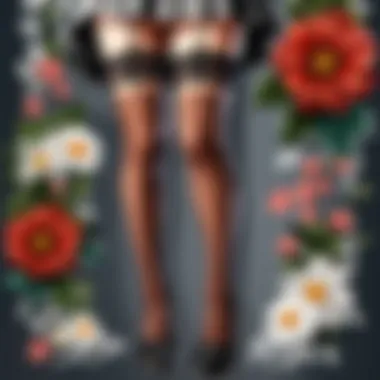

Intro
Stockings vector design isn’t merely a niche; it’s a whole universe where creativity meets technical prowess. When you consider the intricate patterns, colors, and styles that can emerge from the simplicity of a vector graphic, it becomes clear just how much potential lies in this medium. For design enthusiasts, understanding the nuances of stockings vector art can open doors to endless opportunities in aesthetics and functionality.
In this guide, we’ll traverse the landscape of stockings vector design, breaking down the critical components that make it essential in today’s visual culture. From technical insights about vector graphics to the role these graphics play in enhancing design aesthetics, we aim to arm you with the knowledge required to elevate your skills.
The focus here is not only on what makes stockings designs appealing but also on the methods and innovative techniques that can turn basic concepts into striking works. So, whether you’re looking to refine your design projects or seeking inspiration for new ones, this guide will provide a roadmap to navigate the fascinating world of stockings vector art.
Understanding Stockings Vector
Understanding stockings vector is essential for anyone looking to explore design in a modern context. By grasping the intricacies of this subject, designers can leverage unique creative opportunities in various fields, from fashion to digital art. This section outlines the importance of defining what stockings vector is, examining its historical development, and understanding its relevance in design today.
Definition of Stockings Vector
Stockings vector refers to the digital representation of stockings crafted using vector graphics. These graphics are defined by mathematical equations rather than pixels, which allows for scalable artworks without loss of quality. Vectors are particularly useful in graphic design, where precise control over shapes, colors, and gradients is crucial. Unlike raster images, which can become blurry when resized, stockings vector art maintains clarity, making it a preferred choice for designers in various fields, such as gaming and advertising.
Historical Context and Evolution
The concept of stockings in design harks back to their functional and aesthetic purposes historically. Initially, stockings were a practical garment but gradually transformed into a symbol of fashion, often seen in artwork and high-end clothing lines. With the rise of computer graphics in the late 20th century, the stockings vector emerged as designers began to emulate traditional styles in a digital format. This evolution has seen stockings vectors shape the way garments are depicted in digital artwork, enabling designers to push new boundaries in terms of creativity and experimentation.
Importance in Design
The role of stockings vector in design cannot be overstated. Here are some key reasons why they are significant:
- Versatility: Stockings vector designs can be manipulated for various applications, whether in fashion catalogs, video games, or advertisements.
- Creative Expression: They allow for experimentation with colors, patterns, and textures, helping designers to convey unique brand identities.
- Technical Precision: Using vector graphics ensures every element of the design can be scaled without compromising quality, allowing for impeccable detail that can elevate the overall aesthetics.
"A well-crafted stockings vector can transform a simple design into a revolutionary graphic piece that resonates with its audience."
By appreciating the nuances of stockings vector, designers can harness their full potential, crafting compelling works that speak to today's audiences. Dive into the world of stockings vector design, and you'll find it teeming with possibilities, waiting to be explored.
Technical Foundations of Vector Graphics
Understanding the technical foundations of vector graphics is paramount for any designer looking to exploit the full potential of stockings vector design. This section delves into the basic concepts and tools vital for creating and manipulating vector images effectively. The ability to grasp these fundamentals allows creatives to push boundaries and enhance their design projects with efficiency and effectiveness.
Basics of Vector Graphic Design
At its core, vector graphic design revolves around the use of mathematical equations to create images. Unlike raster graphics, which are composed of pixels, vector images maintain clarity regardless of scaling. This quality makes them particularly suitable for products like stockings, which can feature intricate designs. Through the use of points, lines, and curves defined by formulas, designers are provided an endless canvas for creativity. With vectors, the fear of blurry images when resizing is non-existent, making them ideal for both high-end fashion illustrations and character designs in gaming.
Creative expression flourishes when a designer understands how to manipulate these graphical elements. For those interested in exploring the use of stockings vectors, it's essential to become familiar with the underlying principles—starting with Bézier curves and paths, down to the layering techniques that can breathe life into a static image.
Key Software and Tools
There are several software tools available that aid in vector graphic design, each with its own set of features that cater to different needs and preferences. Understanding which software aligns with particular project requirements is crucial. Popular choices include Adobe Illustrator, CorelDRAW, and Inkscape.
- Adobe Illustrator: Known as the industry standard, it offers unparalleled capabilities for creating and editing vectors. The integration of various tools allows designers to achieve professional-grade results efficiently.
- CorelDRAW: This software provides a user-friendly interface and is great for both beginners and seasoned designers, particularly in print design.
- Inkscape: As a free alternative, it's an excellent choice for those starting out. Despite being free, it holds a wealth of features necessary for robust design work.
Each tool comes with distinct advantages that cater specifically to styles, workflows, and budgets.
Creating and Editing Vectors
Creating and editing vectors may seem daunting at first, but with the right approach and knowledge, it becomes an intuitive process.
Using Adobe Illustrator
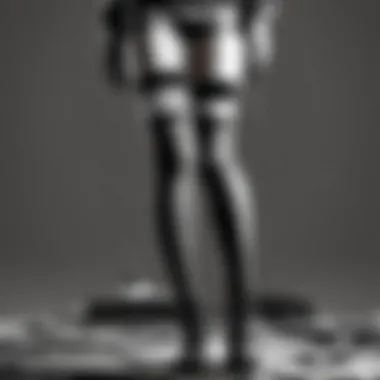
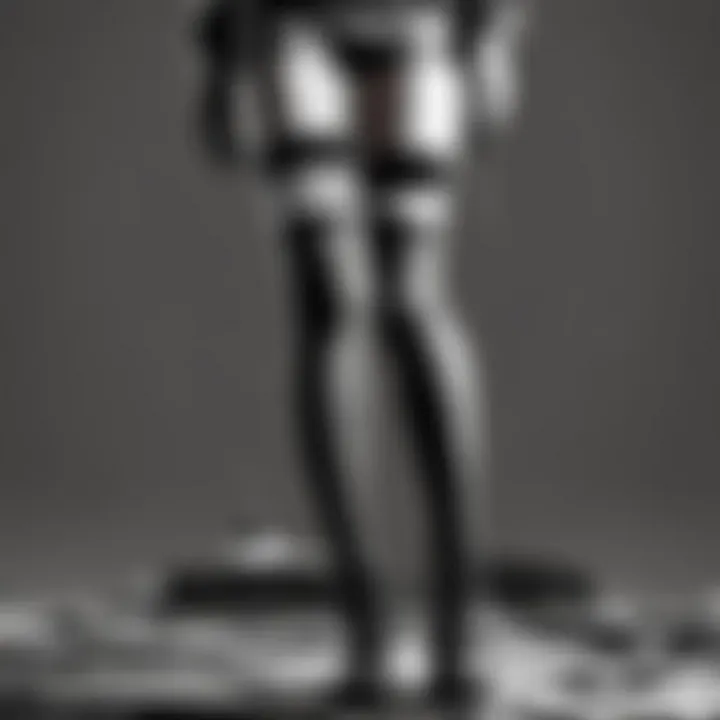
Adobe Illustrator truly shines when it comes to creating intricate vector designs. One of its most celebrated characteristics is the pen tool, which allows for precise path creation. This leads to finely-tuned stockings designs that can exhibit complexity in patterns and gradients. Another unique feature is the Live Trace function, enabling designers to convert raster images into vectors almost seamlessly.
While Illustrator is undeniably powerful, it can be resource-intensive. A robust computer may be needed to handle large projects efficiently. However, its advantage lies in a comprehensive toolset that, once mastered, can lead to a significant leap in one's design capabilities.
Alternatives to Industry Standards
Many designers often explore Alternatives to Industry Standards for various reasons, including budget constraints or personal preferences. One notable example is Affinity Designer. Its key characteristic is the one-time payment model, which stands in stark contrast to Illustrator's subscription model. Affinity Designer provides real-time performance, allowing for smooth manipulation of vector shapes without lagging.
The unique feature of Affinity's live shapes permits rapid alterations and adjustments, making it a beneficial choice for designers aiming for flexibility. However, as with any software, learning curves may differ; some users might find it lacking in certain advanced functionalities compared to Illustrator.
"With design, the world is your oyster; each vector is a pearl waiting to be discovered."
For further reading, consider checking out Wikipedia on Vector Graphics or join discussions on Reddit.
Dive deeper and elevate your design prowess today!
The Aesthetic Appeal of Stockings in Design
The aesthetic appeal of stockings in design cannot be overstated. Stockings, once considered mere accessories, have morphed into pivotal components that can elevate any design narrative. Their unique qualities of texture, color, and visual story-telling capabilities harness the power to engage audiences. In various realms, especially fashion and entertainment, stockings play a remarkable role that intertwines practicality with creativity. They are more than functional; they are expressions of artistry and personal style, making them prized possessions in a designer's toolkit.
Color Theory and Stockings
Color is a fundamental aspect of visual design, and stockings bring a fantastic kaleidoscope into the mix. Different shades can communicate contrasting messages—bold reds may evoke passion and confidence, while soft pastels might suggest elegance and serenity. When choosing colors for stockings in design, it’s crucial to consider the context. For example, a fashion campaign that aims to project empowerment can benefit from bright, striking colors, setting a powerful tone. Conversely, in more subdued designs, earthy tones may harmonize better with other elements, creating an air of cohesion. Understanding how color theory impacts audience perception can easily make or break a design.
Patterns and Textures
Patterns and textures in stockings can serve as a storyteller’s canvas. Polka dots, stripes, floral prints, or even abstract designs can all convey different moods and themes. Textural qualities, whether smooth and glossy or rough and matte, offer another layer of intrigue. Designers are able to mix and match these elements creatively, giving viewers diverse visual experiences. A thoughtfully selected pattern could complement an outfit perfectly or even serve as a focal point in graphic design. The right combination can surprise and delight audiences, ensuring that a concept stays fresh and intriguing.
Contextual Use in Various Genres
Fashion Industry Influence
In the fashion world, stockings have transcended their traditional role, instead morphing into statement pieces. Designers, keenly aware of their potential, have embraced stockings as a medium for innovation. The use of stockings in runway shows allows designers to showcase their vision effectively—whether it’s through sheer materials or outrageous patterns, they can express their brand’s ethos clearly. The key characteristic of fashion influence lies in its daring nature. This bold choice isn’t just about aesthetic; it’s also about stirring emotion and sparking conversation among the audience. Though it can lean toward the avant-garde, a well-executed stocking design can brilliantly enhance the overall fashion narrative, making it a widely-recognized trend across collections.
Gaming and Entertainment Applications
The gaming world has also dipped into the elaborate aesthetic of stockings. Characters adorned with intricately designed stockings can bolster their personalities and appeal to players’ senses. This unique characteristic allows designers to push boundaries and break stereotypes. For instance, fantasy or action games often infuse elements of stockings to create compelling character designs that resonate with players. Here, the advantage lies in character relatability; gamers can connect better to a character that reflects diverse fashion interpretations. However, the challenge remains that overdoing it can detract from a more serious or gritty narrative, leading to mixed receptions from the audience.
The integration of stockings into diverse genres, whether in fashion or gaming, highlights their versatility and impact in design.
In summary, while stockings may seem like a simplistic aesthetic choice, their inherent values—such as compelling colors, engaging patterns, and contextual adaptability—can transform a design from ordinary to extraordinary. Designers who harness these elements can create works that captivate and resonate.
Innovative Techniques in Stockings Vector Design
Stockings vector design has come a long way, transitioning from basic, flat illustrations to elaborate, engaging visuals that can captivate any audience. Several innovative techniques make these designs stand out and ensure they resonate with viewers, especially in fields like fashion, gaming, and art. In the landscape of design, these methods offer benefits such as improved aesthetics, versatility, and user engagement. The following subsections will dive into three key techniques that can elevate stockings vector artwork.
Layering Techniques
Layering is an essential technique in the realm of vector design. The concept revolves around stacking various elements on top of one another to create depth and complexity within the artwork. Each layer can feature different patterns, colors, and effects, resulting in a rich visual narrative.
One of the primary benefits of layering is that it allows designers to manipulate aspects independently, granting the freedom to tweak colors and textures without affecting the entire composition. For instance, a vector stockings design may incorporate intricate lace patterns that are layered over a silky finish. To master layering, a designer could utilize Adobe Illustrator’s Layers panel, ensuring they group related components effectively.
"Layering can transform a mundane design into a striking representation, enriching narratives visually."

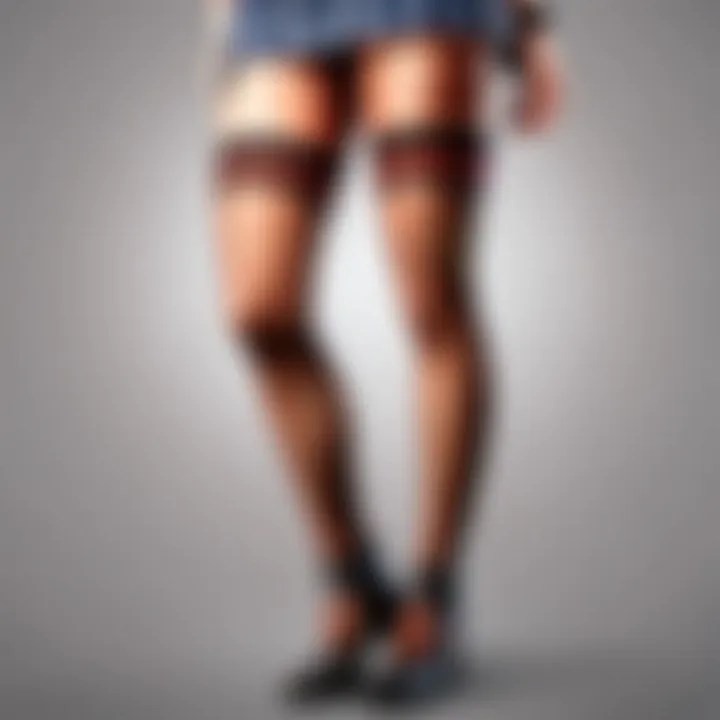
Additionally, the practice of layering can support the overall organization of elements, helping to bring a coherent structure to complex designs. Learning how to balance layers is crucial; too many stacked components might clutter the viewer's focus instead of directing it. The key here is to maintain a visual hierarchy that guides the eyes.
Dynamic Color Gradients
Dynamic color gradients have become a game changer in vector design. These gradients create an illusion of depth and movement, making stockings appear almost three-dimensional. By transitioning colors smoothly across the vector space, designers can evoke emotions and set moods that static colors simply can’t achieve.
The use of gradients can be particularly effective in enhancing skin tones and textures in fashion-oriented designs. A stocking’s hue might blend seamlessly from a light beige at the ankle to a deeper espresso at the thigh, simulating how light interacts with fabric.
To implement these gradients effectively, it’s crucial to select color pairs that complement and contrast without clashing. Tools like Adobe's Gradient Tool can assist in crafting flawless transitions. Choosing color schemes that align with current trends can also give designs a modern appeal.
Incorporating gradient meshes offers even greater control, allowing artists to manipulate points within the gradient for more precise color distribution. Keeping up with gradient trends can also play a critical role in design relevance, especially for the fashion-forward crowd.
Integrating Photography and Vectors
The intersection of photography and vector design brings a fresh perspective to stockings vector art. This technique employs photographic elements within a vector-based environment, allowing designers to blend realistic images with stylized illustrations. The end result can be visually captivating, adding layers of realism to otherwise flat graphics.
Consider a scenario where a designer uses a high-resolution image of a cityscape as a backdrop to their fashionable stockings artwork. By overlaying vector styles—like striking lines and patterns over the photograph—designers can create unique hybrid illustrations that stand out. When using this technique, it’s pivotal to ensure that the photographic and vector elements harmonize in terms of color and style.
To enhance cohesiveness, designers often apply similar filters or effects to both photographic and vector elements. Additionally, resources like Adobe Photoshop can be used to manipulate images and prepare them for vector conversion, leading to smoother integration and a polished finish.
By leveraging these innovative techniques—layering, dynamic gradients, and integrating photography—designers can elevate the world of stockings vector. They open gateways not just for creativity but also for practical applications across a multitude of design disciplines. Engaging with these methods deepens the aesthetic appeal, making design work not just function-driven, but rather vibrant and full of life.
Practical Applications of Stockings Vector Design
The practical applications of stockings vector design underscore its significance in modern creative practices, offering a plethora of possibilities for those who delve into this versatile art form. Designers across varying fields leverage stockings vectors to not just enhance visual appeal but also to convey intricate themes and narratives within their works. The importance of properly applying these vectors can’t be overstated; they are a bridge between concept and execution. Understanding their utility allows designers to maximize the impact of their creative endeavors while speaking more directly to their audiences, especially to niche markets like PUBG players and other gaming enthusiasts.
Fashion Campaigns and Advertisements
In fashion campaigns, stockings vectors serve as vital components that breathe life into visual storytelling. It’s not just about showcasing a product; rather, it’s about evoking emotions and setting the tone right.
- Enhancing Brand Identity: Utilizing unique stockings designs can elevate a brand’s identity. For example, a campaign for Calvin Klein may opt for minimalist vector stockings, conveying both elegance and simplicity.
- Vibrant Visuals: High-quality vector designs can create vibrant advertisements that draw the eye. Imagine a colorful graphic showcasing an outfit complemented by intricately detailed stockings. Such details can resonate with the audience’s taste for boldness or subtlety, depending on the brand's direction.
- Easy Modification: Stockings vectors are editable, allowing brands to swiftly adjust colors or patterns to suit seasonal campaigns or specific customer feedback.
This adaptability not only speeds up production but also means that brands can respond more dynamically to trends in fashion and social media buzz. With the rise of online platforms, having adaptable visuals is more essential than ever.
Game Design and Character Creation
Stockings vectors also play a crucial role in the world of gaming, particularly in character design. Gamers are often drawn to unique characters that reflect their personalities or preferences, and stockings can add that little something extra to make characters memorable.
- Character Customization: By allowing players to choose different stocking designs for their characters, games can enhance personalization. For instance, in a game like Fortnite, various designs can relate to players’ identities.
- Creating Atmosphere: Stockings’ design can contribute to a character’s aesthetic, reinforcing the game’s overall tone. Whether a character is meant to appear fierce, elegant, or humorous, the right stockings vector can help convey that.
- Marketability: Well-designed character outfits that include appealing stockings can lead to successful merchandise opportunities and downloadable content (DLC), attracting not only players but also collectors.
As players engage deeply with characters in the games they love, the details, especially those like stockings that add flair, become essential.
Art Installations and Exhibitions
In the realm of art installations and exhibitions, stockings vector design can present a thoughtful commentary on fashion and identity. Artists have begun using stockings vectors as a medium for social expression, transforming simple items into powerful pieces that provoke thought and emotion.
- Cultural Narratives: Artists may use stockings as an emblem within their work to tackle themes of gender, fashion, and social norms. This veers further away from the conventional, offering fresh perspectives that connect with audiences on multiple levels.
- Interactivity: Installations can encourage viewer interaction, where visitors can engage with their own stockings designs, thus personalizing the exhibit experience and enhancing its memorability.
- Sustainability Focus: As sustainability becomes a global focus, artists can utilize vector designs that promote eco-friendly materials and practices within the fashion industry, urging audiences to consider their consumption habits.
In essence, the applications of stockings vector designs extend far beyond traditional boundaries. From dynamic fashion campaigns to intricate video game characterizations and reflective art installations, these designs are a powerful tool for engaging and influencing diverse audiences. Designers looking to capitalize on these opportunities should keep their innovative spirits high while grounding their work in purpose and meaning.
Challenges in Stockings Vector Design
Designing vectors that incorporate stockings presents its own unique set of challenges that can confound even the most seasoned of designers. Understanding these challenges is crucial, as overcoming them can lead to designs that are not only aesthetically pleasing but also highly functional. In this section, we'll analyze the key issues faced in stockings vector design, emphasizing the interplay between visual appeal and practical usage, avoiding common traps, and suggesting methods for self-reflection and improvement in your design work.
Balancing Aesthetic and Functionality
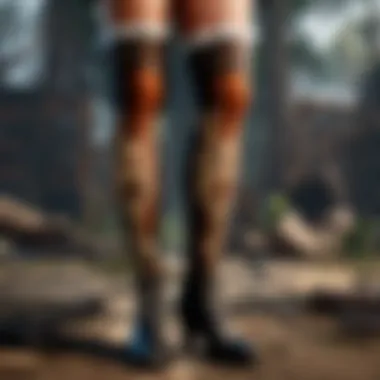
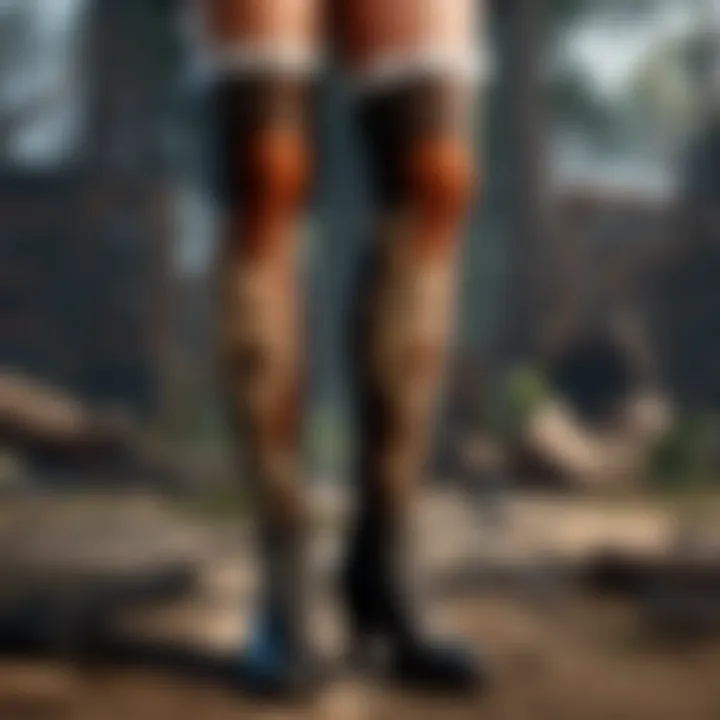
One of the most notable hurdles in stockings vector design is the age-old debate of aesthetics versus functionality. Designers often find themselves in a tight spot, attempting to create a piece that captivates attention while also serving its intended purpose effectively.
When creating a vector design with stockings, it is critical to ensure that the visual elements do not overshadow their functionality or lead to confusion about their use. For example, when designing for the fashion industry, the design must reflect current trends while ensuring it can be produced efficiently. In gaming contexts, character creations must look realistic while also conforming to the gameplay mechanics.
Things to keep in mind while balancing these elements:
- Ensure designs are easily recognizable
- Use colors that align with the brand’s identity
- Maintain a clean design that doesn’t distract from the core message
- Test designs in various formats to see how they hold up in real-world applications
Avoiding Common Pitfalls
Navigating the waters of stockings vector design is not without its snares. Designers often fall into traps that can stifle creativity or lead to unsatisfactory outcomes. Common pitfalls include over-complicating designs and neglecting scalability.
Overly intricate designs may look appealing initially but can create issues when printed or displayed digitally, leading to a muddled result. It's also essential to consider the scalability of designs. If an image is too detailed, it might lose clarity when resized for smaller formats. In design, simpler often means better. To steer clear of these pitfalls, take the following actions:
- Regularly simplify your designs, focusing on core elements
- Make use of vector software's tools to create high-quality outlines
- Always preview your design in multiple sizes and formats
**"Less is more" stands true in vector design, enabling clarity while enhancing visual impact."
Critiquing and Improving Your Work
Once you've created a stockings vector design, the process doesn't end there. It's crucial to revisit your work with a critical eye. Self-critique allows you to identify the strengths and weaknesses of your design, fostering a sense of growth. Here are some noteworthy strategies for critiquing your work:
- Pause and Reflect: Step away from the design for at least a day. Returning with fresh eyes can reveal overlooked issues.
- Seek Feedback: Don’t shy away from sharing your work with peers or online forums like Reddit or design groups. More perspectives can spotlight areas for improvement.
- Keep a Journal: Document your design process and the challenges faced. This record will be valuable for future projects.
These practices can lead to a more refined design approach, allowing for continuous improvement.
In summary, the challenges in stockings vector design may seem daunting, but they are manageable with the right strategies. Emphasizing balance between aesthetic appeal and functionality, steering clear of common traps and incorporating a solid critique process are fundamental to achieving design excellence. The key lies in adapting your approach and remaining open to learning—the bedrock of a successful design career.
The Future of Stockings Vector Design
As we move deeper into the 21st century, the realm of stockings vector design holds a dynamic and evolving landscape. The importance of understanding the future of this niche in design cannot be understated. It’s not just about aesthetics; it intertwines with technology, market demands, and consumer preferences that shape the creative processes of today. In this section, we will explore the emerging trends, the influence of augmented reality, and the growing emphasis on sustainability.
Emerging Trends and Technologies
The design world is buzzing with innovation, and stockings vector design is riding that wave. Some trends on the horizon include:
- Interactive Elements: A growing user expectation is for design elements to be more interactive. Stockings vectors now integrate motion and hover effects, bringing static images to life in web and app design.
- Customization: Consumers are increasingly leaning toward personalization. This means that designers must be equipped to produce customizable vectors that allow clients to pick colors, patterns, and styles that resonate personally. Websites like Redbubble and Zazzle have been paving the path for such custom designs.
- 3D Integration: As 3D modeling grows in popularity, there is a tendency towards integrating 3D aspects into vector design, offering a richer visual experience. Graphic designers can utilize software like Blender or SketchUp alongside traditional vector-based tools, leading to hybrid designs that pop off the screen.
The aforementioned trends signify a shift towards more vibrant, engaging, and user-centric designs that satisfy modern sensibilities.
The Impact of Augmented Reality
Augmented reality (AR) is no longer just a buzzword; it's becoming a reality for designers. The intersection of stockings vector design and AR presents vast potentials:
"With AR, one can envision stockings designs in real-world settings, transcending traditional boundaries of format and presentation."
- Visual Testing: Users can see how a pattern looks on an actual device or fabric before making a purchase. This reduces returns and enhances customer satisfaction.
- Enhanced Marketing: Imagine a fashion campaign where potential buyers can virtually try on stockings designs through their mobile devices. This technology creates an engaging way to showcase new products, making marketing efforts more effective.
- Immersive Experiences: Brands can develop an entire AR experience around stockings vectors, enhancing viewership through interactive storytelling—extremely effective for the gamers and esports communities that crave immersion in their experiences.
The influence of AR is set to revolutionize how consumers interact with design, making it more relatable and engaging than ever before.
Sustainability in Design Practices
The future of stockings vector design is not just about the latest trends and technological advancements; sustainability is a crucial element that designers must consider. With consumers increasingly aware of environmental impact, there are several considerations:
- Eco-Friendly Processes: Designers are exploring vector graphics that require fewer resources, reducing the carbon footprint associated with production. Digital designs can lead to less waste compared to traditional fabric sourcing and production.
- Sustainable Materials: While vectors themselves are digital, the tangible products often still need material consideration. By embracing organic fabrics or recycled materials in the final products, designers contribute to a more sustainable lifecycle.
- Consumer Awareness: Educating the audience on sustainability issues connected to fashion through smart designs can drive more ethical consumer choices. Providing transparently sourced designs allows consumers to align their values with their purchases.
The focus on sustainability in design practices highlights that the future is not merely about what one can create, but how it can be created responsibly. This direction paves the way for a more conscientious approach to design overall.
In summary, the future of stockings vector design holds continual promise and excitement. By harnessing emerging trends, leveraging new technologies like augmented reality, and emphasizing sustainability, this niche has the opportunity to evolve and cater to a discerning audience that values both innovation and responsibility. As we dive into an era where design meets ethical principles, the realms of creativity and sustainability become eerily intertwined, promising a future that is as responsible as it is beautiful.



